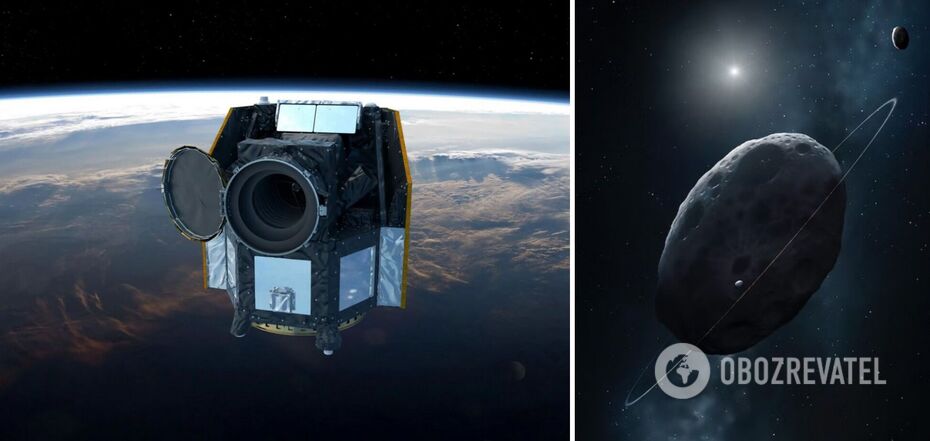Life
Scientists found a ring on the dwarf planet Quaoar that contradicts science
The European Space Agency's CHaracterising ExOPlanet Satellite (Cheops) space observatory has discovered a ring around the transneptunian object Quavar in the Kuiper Belt that contradicts the laws of science known to mankind. Now scientists intend to study the discovery in more detail and revise the conclusions about the existence of the Roche limit.
OBOZREVATEL tells the details about Quaoar, which is sometimes called a dwarf planet and explains what exactly its ring surprised scientists.
Quaoar
Quaoar is one of the nearly 3,000 transneptunian objects (TNOs) that are in our solar system, mostly or permanently outside the orbit of Neptune. It has a diameter of 1,110 km, making it the seventh largest TNO (Pluto and Erid are the largest). Also moving next to it is an 80-kilometer satellite, which has been given the name Wayvot.
This object was first discovered back in July 2002 by astronomers at the California Institute of Technology, and the ring around it was discovered through observations that were conducted from 2018 to 2021.
Recent observations of Quaoar have been made during so-called oculations (or eclipses), when the object passes distant stars, briefly blocking their light. Observations at such times allow scientists to determine the size and shape of the object. In addition, during such observations, scientists can determine whether the object has an atmosphere of its own.
Studying dwarf planets like Quaoar is extremely difficult because of their small size, as well as the extreme distances at which they are located. Kvavar orbits the Sun at a distance of nearly 44 times the Sun-Earth distance.
But thanks to data from Cheops and information from large professional observatories around the world, scientists were able to get clear confirmation about the amazing ring around Quaoar.
"We saw a drop in brightness, not caused by Kwawar, but indicating the presence of material in a circular orbit around it. Once we saw that, we said, 'OK, we see a ring around Quaoar,'" said Bruno Morgado of the Federal University of Rio de Janeiro, Brazil, who led the data analysis.
The Quaoar ring is much smaller than Saturn's, but is extremely interesting to scientists. Its uniqueness lies in where it is located in relation to Quaoar itself.
The Ring and the Roche limit
Any celestial object with a gravitational field has a so-called Roche limit, which is the closest distance to a planet within which another celestial object, if approached, would be torn to pieces and turn into a ring.
"So, what's intriguing about this discovery around Quaoar is that the ring of material is much further away from Roche's limit," explained Giovanni Bruno of the INAF Astrophysical Observatory in Catania, Italy.
The fact is that, according to scientific data, the rings beyond the Roche limit have been merging into a small satellite for several decades. That is, the ring around Quaoar should have turned into another of its satellites long ago.
"As a result of our observations, the classical notion that dense rings survive only within the Roche limit of a planetary body should be thoroughly reconsidered," Bruno believes.
His colleague's surprise is shared by Morgado. "The Ring of Quaoar is not where we expected it to be," he states.
Morgado notes that planets and asteroids have satellites, rings, or both. Roche's limit explains why one of the two forms, but cannot explain the ring around Quaoar.
"If you have a satellite that falls within that limit, it will break up and become a ring because of gravitational forces, tidal forces. Conversely, if you have a ring that goes beyond the Roche limit, that ring will start to accrete and it will start to become a satellite," the scientist notes.
This discrepancy between theory and data means that perhaps the Roche limit needs modification. Or there is some unknown force acting on the ring, holding it in an unusual place.
Scientists speculate that perhaps the ring can't assemble into a ball, because it may be hindered by the ultra-low temperatures on Quaoar, which have turned the particles in the ring into ice floes. But further research is needed to substantiate this theory.
There is also the unlikely assumption that researchers have stumbled upon the moment when the ring is just beginning to turn into a satellite. But the probability of such a discovery is so small that scientists themselves do not believe it.
Previously OBOZREVATEL published photos and video of the "green comet" that flew past the Earth at the closest distance for the first time in 50 thousand years.
Subscribe to the channels of OBOZREVATEL in Telegram and Viber to keep up with the latest events.



























